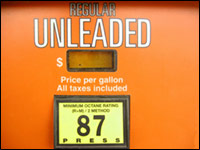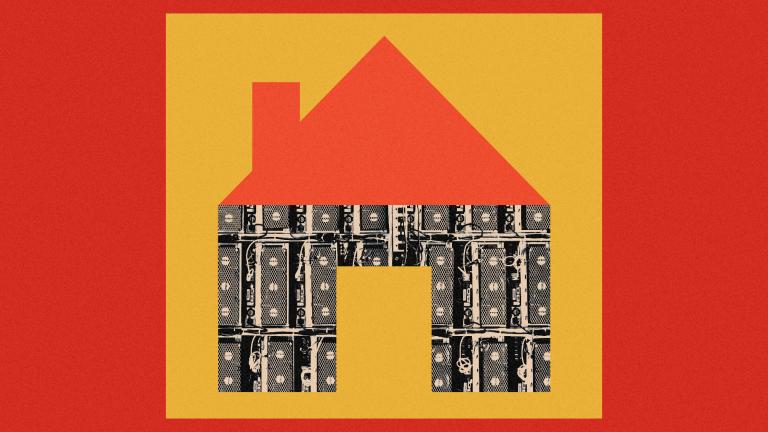The following is part one of a guest essay from Charles Komanoff, an economist and environmental activist in New York City. For more on taxing carbon fuels, go to http://www.komanoff.net/fossil/.
For part two of this essay, go here.
—–
“Pam and Matt Keith spent Memorial Day weekend on a houseboat on Lake Oroville in Northern California. But because of high gasoline prices, the Keiths never even untied the boat from its mooring slightly offshore. When they ventured away from the shore, they supplied their own power — in kayaks.”
So began The New York Times take on the start of the summer driving season in an age of $3 gas: “Holiday Travelers Hit the Road, but Scrimped a Bit.”

The Times’ page-one piece was guaranteed to bring smiles to both economists and despisers of motorized recreation. As a member of both camps, I ate it up. I loved that the Keiths were kayaking instead of houseboating around the lake, and that another California couple, Celia and Michael Shane, had shelved their annual jet-skiing trip in Lake Mead National Recreation Area in Nevada. “To save the $70 per tank it now costs to fill up their minivan,” the Times reported, "the Shanes were barbecuing instead.” For guys like me who can let a single roaring jet ski ruin an entire beach day, fewer decibels mean more happiness. And after a year’s drumbeat of articles insisting that higher gas prices hadn’t dented Americans’ “love affair with their cars,” it was heartening to see the paper of record start acknowledging the No. 1 tenet of economics — higher prices mean lower demand.
The world’s thirst for petroleum breeds war, props up dictators, and imperils the climate. Known oil deposits are shrinking by the day. So no question in economics is more pressing than whether, and by how much, changes in the price of gas reduce the demand for it. I’ve been examining this question since May 2004, when the price first edged past two bucks. Every month I faithfully enter the latest price and consumption data into a spreadsheet. This has to be done just right. For one thing, because gas use follows seasonal patterns, monthly data must be compared over intervals of 12 months (or 24, etc.). For another, changes in price must be adjusted for general inflation. Most important is netting out the upswing in gasoline use that ordinarily accompanies expanding economic activity when the price of gas is stable. Only after taking these steps can one isolate the effect of higher pump prices on gasoline demand.
What my spreadsheet shows is that higher gas prices are dampening gas use. Not hugely, but enough to command attention. True, demand isn’t down in absolute terms, but it’s practically flat, which means it’s lagging the higher levels it would otherwise be reaching due to economic growth. For all of 2005, with an economy 3.5% bigger than the previous year’s, gasoline usage was up only 0.2%. Similarly, purchases of gasoline in April 2006 (the most recent month available) were just 0.1% greater than in April 2005, even though the economy was almost 4% larger.
What emerges from these numbers is a “price elasticity” of around 20% (economists write this as 0.2). This means that declines in gasoline usage due to rises in price are averaging 20% as much as those same percentage changes in price. For example, a 10% rise in the price of gas engenders a 2% drop in demand. This 20% ratio has held remarkably constant over the past 24 months, never straying beyond a range of 11%-26% (provided I use three-month “moving averages” to smooth out monthly variations in inventories).
It turns out, then, that Americans have been responding to the rising price of gas by using less. As a smattering of articles have reported, many of us are cutting out a few car trips here and there, shortening a few others, occasionally carpooling, now and then leaving the SUV in the driveway and taking the sedan, perhaps trying a lighter touch on the gas pedal, even walking or biking occasionally. The overall impact, while modest, is visible in my spreadsheet nonetheless. And it’s been proportionate: small price rises evoke small changes, big hikes bring bigger ones.
But, you ask, if the price-elasticity of gasoline is 20%, how come the recent doubling of gas prices — in percentage terms, a 100% price jump — hasn’t dropped demand by 20%?
There are two reasons: first, gas prices haven’t doubled. In fact, they’re not even up by half. Notwithstanding the mass near-hysteria over prices at the pump, the average 2005 price, $2.34, was just 43% higher than the average 2003 price, $1.64. Adjusted for inflation, the two-year real increase was 34%, or roughly one-third — a long way from doubling. Even $2.80 gas this April, the highest monthly price ever save for the post-Katrina spike last fall, was only 16% higher in real terms than the April 2005 price and just 39% higher than April 2004. By these terms, compared to two years ago demand should be down just 7-8% (I got that by multiplying the 20% elasticity by the roughly 35-40% real price increases).
The second point is that the basically flat demand compared to two years ago indeed constitutes a drop of 7-8%, relative to where demand would have been due to the economy’s being 7-8% bigger.
—–
For part two of this essay, go here.



